Escape From Baja: Mexican Torture Test of Audi 5000S, Datsun Maxima, Dodge 600ES, Pontiac 6000STE, Saab 900 Turbo, Toyota Cressida, VW Quantum, Volvo 760GLE
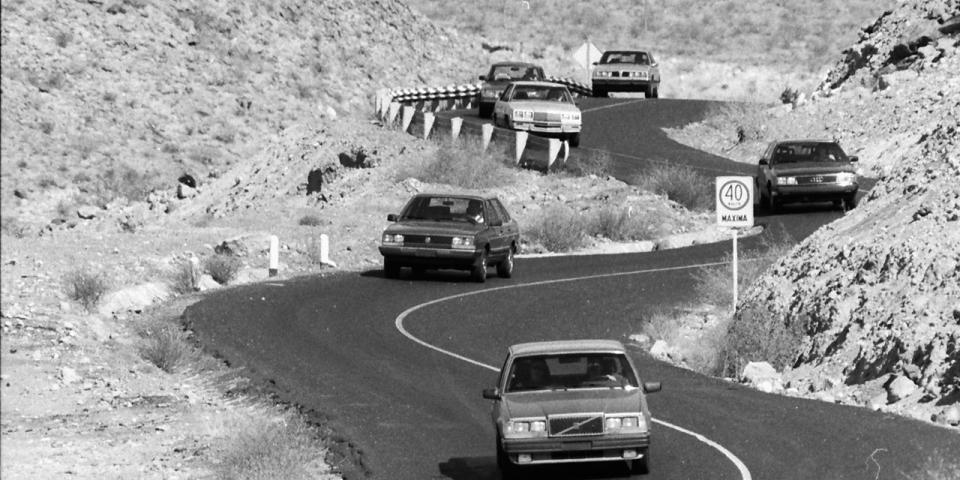
From the July 1983 Issue of Car and Driver
This affair began as an honest attempt to evaluate eight sedans in the European idiom over a 2300-mile route between Southern California and the tip of Baja California in Mexico. Decent, responsible automotive journalism. Road & Track does this high-adventure stuff all the time. On more than one occasion, they have encountered overcooked cheeseburgers and canceled motel reservations. It even rained once. As for us, it got a little more complicated. In retrospect, that was to be anticipated, when you consider that our widely esteemed technical director, Donald Sherman, organized the campaign.
Before the mission was completed, the hapless followers of Sherman faced bouts of the turistas, numerous encounters with the Mexican federales, a high-speed collision with a cow, floods, maroonings, the deep-sixing of a Datsun Maxima, and the consumption of more high-octane tequila and stomach-scouring Mexican food than any collection of Americans since Blackjack Pershing chased Pancho Villa.
But let's not carry this military analogy too far. If our Sherman, and not William Tecumseh, had devised the original March to the Sea, Richmond, Virginia, would be the capital of the United States and Jesse Helms would be president. So be warned that what follows is no normal meander over tic byways in search of automotive truth. This, Bucky, was a freaking war...
Sunday: We leave Newport Beach (yes, yes, we know, we know) in the midst of the 49th monsoon to hit Southern California this year. Ugly nimbus clouds roll in off the sea. There are ten of us, high-type professionals all. There are eight automobiles: two American (a Pontiac 6000STE and a Dodge 600ES); two Japanese (a Datsun Maxima and a Toyota Cressida); and four from Europe, where this brand of machine was born (a new Audi 5000S, a VW Quantum, a Saab 900 Turbo, and a Volvo 760GLE). Euro-sedans. Four-doors. Priced between $10,000 and $20,000, bracketed by the likes of the Honda Accord on the low side and the BMW 528e on the high. The mission: a two-day, 1150-mile, America-versus-the-world run to Cabo San Lucas at the tip of Baja, then a one-day layover in the sunshine and two days back. Our destination today is an oasis in the central Baja desert called San Ignacio.
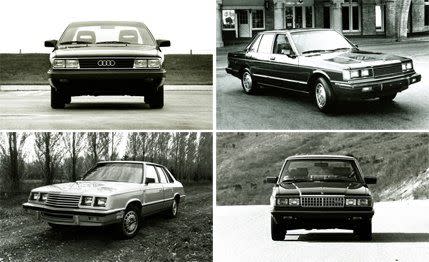
Reaching the border is simple. Our one nod to preparation is a supermarket stop to grab some bottled water. Otherwise, we exit the United States with the same level of preparation one might employ for a trip to the K mart: no tools, lights, or first-aid kits. When other magazines go to Baja, they're outfitted like the Afrika Korps. But we have one trump card: a childlike faith that our leader will bring us through.
A chunky guard waves us into Mexico at Tijuana. The four-lane to Ensenada is pocked with tightly radiused curves. An ancient Volvo wagon with California plates races us at 80 to 90 mph all the way to Ensenada, but none of our eight cars is even breathing hard as we stop for lunch. Our next encounter with Mexican officialdom comes in the parking lot of Hussong's Cantina, where one of the least civilized members of our group [Yates—Ed.] is arrested for recycling several liters of Dos Equis against a wall. Lindamood, the only one among us who speaks any Spanish, gets the culprit off with a ten-dollar fine by denouncing him to the cops as a pig.
We plunge into fast, twisty two-lanes south of Ensenada. Route 1 rides high along some splendid seacoast vistas toward San Quintín and then bores inland to the mountains at El Rosario. We wonder but say nothing about customs. Having blasted past the place where the Maneadero checking station was supposed to be, we may be operating as Yanqui wetbacks, without the faintest authorization to penetrate so deeply into the nation. No matter: the cars are running well, the night is cloudless, and the road is clear, save for an occasional bus and the odd battered pickup.
Our only glitch comes when we switch cars in the darkness. Several of the party, seeking naps, double up. We drive away, leaving the Maxima and the Quantum at the roadside, and have to race back fifteen miles to retrieve them. The fact that Sherman detected the error so quickly means that his plan is working to perfection.
Monday: Is B. Traven running a haberdashery in San Ignacio? Mr. Davis, Jr., is wearing a snap-brim felt hat, last seen on Walter Huston in The Treasure of the Sierra Madre. The tiny, dust-caked village sits in a basin clustered with date palms planted by the Spaniards when the Jesuits started their mission here in 1728. We take a leisurely tour of the ancient stone church before rolling south. Empty roads beckon. Speeds rise. Large signs warn, "Designed to Promote Economic Development, Not for High-Speed Driving," but make little impression. Nor are we slowed by the curvas peligrosas, which are generally punctuated by burned-out car hulks, rumpled guardrails, and coveys of handmade crosses. Stray cattle begin to appear at the roadside, spavined beasts that pay no heed to the passing vehicles. The immense steel bumpers on the big Dina trucks we pass begin to assume a meaningful function.
We switch cars, and impressions begin to gel. Sherman, Csere, Ceppos, and Griffin are delighted with the new Audi, despite its slightly sterile aura. Committed traditionalist P.J. O'Rourke reveals a quiet loathing for front-drive cars and extols the rather zany handling of the amply powered Cressida, a schoolmarm with a harlot's heart. The Pontiac and the Dodge are pleasant surprises. Who can remember a Detroiter that would absorb such extended hard driving without frying its brakes, boiling its coolant, and loosening up like a Hong Kong toy? The Volvo, which appears to have been styled from an old Amapa upright freezer, may entice Electra 225 devotees. The Saab and the Maxima charge along with terrierlike enthusiasm, while the Quantum, for all its quiet competence, becomes the wallflower of the group.
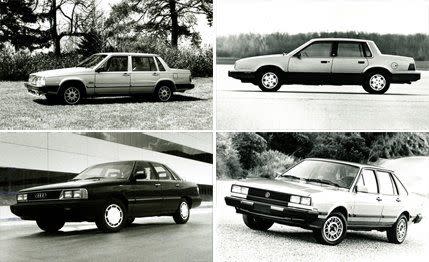
We are ambushed by the cops in La Paz. They want a closer look at our new cars. Lindamood is brilliant as she aborts impending arrest by demonstrating the Datsun's idiotic synthesized voice to the awe-struck lawmen.
It is a black night in the mountains. Our little convoy is rushing the final miles to Cabo San Lucas, when Csere nails a cow. He centerpunches a 500-pound black steer, at maybe 60 mph. Protein for the people! One wounded Dodge 600ES, but thankfully, no other injuries. We grope in the lonely darkness to assess the damage. The hood is shredded. The roof is dented. The car runs happily, but the radiator is ruptured. We push the car 60 miles—primarily with the purposeful Audi—to our hotel. Angry guests blunt our beach-front attempt to celebrate our arrival.
Tuesday: Too much sun, too many piña coladas, but good news: the Dodge survives. Sans hood, it is ready for the run back home. Lindamood and Ceppos fall to the dreaded turistas.
Wednesday: On the road before dawn, heading back to San Ignacio. The Dodge is gaining fans by the hour. Hard driving in the mountains reveals an interesting fact: the automatic-transmission cars—the Volvo, the VW, and the Pontiac—can be driven as quickly as and more easily than the five-speeds. Ominous clouds build in the north.
The federales nail us north of Loreto. Suspicion about the Dodge's missing hood is our downfall. The cop is a young, round-faced kid in a clapped-out Dodge cruiser with bald tires. His girlfriend is riding shotgun. The cop wants to see a report on the cow collision, but we have none. This is not a good situation. We deploy Sherman and Lindamood in the 600ES for the drive back to Loreto with the federale. The rest of us head north to a rendezvous at San Ignacio. It is raining seriously now, and the vados (low spots in the road, meant to allow flash floods to run off) are beginning to puddle. The storm hits as we arrive at the La Pinta Hotel in San Ignacio. The wind pounds at the palm trees, the rain hammers on the roof. We toast our lost comrades, who may be rotting in a Loreto calabozo by now, with numerous tequilas and beers.
Sherman and Lindamood arrive late. Because of power outages, they have had to scavenge gas twice to get the Dodge home. The federale adventure turned to comedy: Lindamood ended up driving the patrol car and manicuring the cop's girlfriend's nails, while Sherman repaired a copy machine for the cop. Weirdness in the Mexican desert has cost a meager $50 fine.
Thursday: A predawn escape is attempted. It is still raining. Sherman is back in command. He should have tried U-boats. Fifteen miles north of town, he crests a hill and skates into a storm-swollen vado. We arrive a few moments later. Our headlights probe into the darkness to reveal the Maxima awash in the turbulent water. Sherman has slogged ashore mumbling about a lack of channel buoys.
We are marooned in San Ignacio. Vados have flooded on both sides of the town. Aaron Kiley is briefly stranded between two gulley washers while taking pictures. The poor Maxima is hauled out of the water and towed back to the hotel. A dry-out will be attempted, but the fuel injection's brain has gurgled its last. Our only alternative is more food and drink in a terrific little restaurant called Quichule while we wait for the creeks to quit rising.
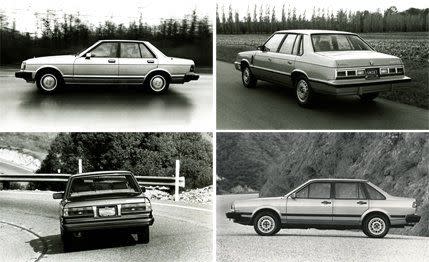
Friday: The parking lot floods, and we move the cars. Save for the drowned Maxima, they are running well. The Pontiac has developed an antipathy to the urine-quality Mexican gasoline and the Cressida's dash has a faint tick, but otherwise the machines have resisted every sort of abuse we could heap on them. More may be demanded, however. Word filters in that the road north is devastated. Weeks may pass before we can escape. Pass the tequila.
Saturday: We devise a crafty plan. There is a back-country trail out of town. It meanders through the garbage dump and over the desert to join the highway. We will double back south to La Paz and evacuate by airplane. Our refugee party is joined by Dick Ryan—Baja veteran, ace dove hunter, and retired Northwest Airlines pilot—who, with his wife, Jody, is trying to return to Santa Barbara. An old Mexican named Luis, who wants to get to Santa Rosalía, is our guide. The seven remaining cars (the Maxima is left behind) scramble tentatively over the rocky trails.
Finally, we are free of San Ignacio, and the road is clear and dry. The federales run us down one more time, threatening a two-day impoundment, arrests for our 100-mph daisy chain, and big fines, but Jody Ryan, who is fluent in Spanish and one salty lady, hectors them down to 2000 pesos (about fourteen U.S. dollars). Let's hear it for police corruption. After a shower at the Los Arcos Hotel and one last assault on Mexican cuisine, we make a lucky feint past the customs officials and board an Aeromexico flight to Los Angeles.
Now all we've got to do is figure out what to do with eight stranded automobiles.
Epilogue: Ten days later, Sherman and six assistants flew back to La Paz to liberate the cars. The flood tide had subsided, and the roads were generally in excellent shape. Two days of driving put the survivors back on American soil. (The ill-fated Maxima was trailered to civilization.) There was no further contact with the federales, and the feared confrontation at the border failed to materialize. —Ed.
Track vs. Torture Testing
Sporting sedans have one of the toughest job descriptions in the car cosmos. They are expected to perform as well as two-seaters in the critical go, stop, and turn categories. They must have plenty of room for four or five passengers to stretch out for the long haul and decent luggage accommodations as well. Deep-seated comfort is of course a requirement, and then there are the practical concerns: fuel economy, reliability, upkeep expense, and depreciation. Last and most important, a great sports sedan is endearing: it must have both the poise to entertain over the most trying roads and the grace to look charming whether the dress code is freshly waxed fenders or Baja trail dust.
Is America ready to stand up and be counted in this gathering of the four-door elite, or do we still have to bow to builders across the waters? A hard look at the performance profiles of our eight contestants tells the tale. The Pontiac 6000STE scored three first-place ratings (70-to-0-mph braking, top-gear acceleration, and interior sound level), one tie for first place (with the Audi 5000S in roadholding), and a respectable third place in through-the-gears acceleration. Sound the trumpets and wave Old Glory: at last you can buy a made-in-America machine that will match fenders with the best of the Black Forest. The Dodge 600ES didn't fare nearly as well, partly because it had the lowest horsepower allotment, but it was in no way embarrassed by the latest and greatest from Japan, Germany, and Sweden in the $10,000-to-$20,000 class.
The test-track performance statistics tell more. The modern radial tire must still be an enigma to the Japanese: the Toyota Cressida and the Datsun Maxima fell down in both braking and roadholding. One manufacturer from the Far East clearly had its concentration fixed under the hood: the Cressida had no trouble keeping pace when the road opened up, thanks to a glorious six-cylinder engine that boasts plenty of displacement, a twin-cam cylinder head, electronic fuel injection, and the most horsepower going. Saab, on the other hand, has done a remarkable job of turbocharging our test's smallest engine: the 900's 2.0-liter motor is smooth, energetic, respectfully mid-pack in fuel efficiency, and, most important of all, an absolute blast to drive.
The test results and a week on the road convinced us that it may be time to rethink our transmission prejudices. The Pontiac's strong acceleration and the Volvo's ability to cruise without commotion prove that an automatic doesn't have to be a hardship in the sports-sedan context. What's more, the classic favorite—a five-speed manual—is poorly executed in the Dodge 600ES. First, its flaccid cable shift linkage is quite out of place in the dedicated-to-driving class. Second, although Dodge engineers used their gearbox to score a remarkable 38 mpg on the EPA highway test, in the process they threw fourth- and fifth-gear flexibility out the window (note the lackluster top-gear-acceleration results). The two top ratios are suitable only for level-road cruising, a situation that saps much of the sportiness from an otherwise capable sedan. Beware of sky-high EPA highway ratings!
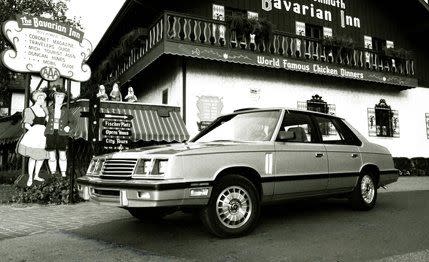
While we're slaughtering a few sacred cows with our test results, it should be noted that there is almost no correlation between a car's speediness and its fuel efficiency. Over the course of our 3200-mile trip, the eight sports sedans fell into three distinct fuel-economy clusters: two at 19 mpg, four at 21 or 22 mpg, and two at 24 mpg. The heavy, automatic-transmission-equipped machinery did happen to fall to the bottom, but the cars at the top were by no means the slow, featherweight sedans of the test. The 24-mpg Audi 5000S, in fact, is an excellent case study in up-to-date engineering. Carefully tuned aerodynamics, a fairly potent engine, a wide-ratio five-speed, and a reasonably light chassis delivered the test's top fuel efficiency and very competitive scores in acceleration and top speed.
One detail only hinted at by the cold performance statistics is that the Audi is also a great driver's car. The real world tells all in this regard, which is precisely why we followed the test-track trials with a 3200-mile run up and down Baja's frijole freeway.
On the road, top-gear acceleration takes on major importance. Hustling out of the tight mountain bends and into the long, straight chutes, the Pontiac, the Toyota, the Saab, the Volvo, and even the VW Quantum marched smartly away from the Audi, the Maxima, and the Dodge. Similarly, the first corkscrew tells more about braking than a simple 70-to-0-mph stopping test. Every car in the fleet performed remarkably well here; there was absolutely no evidence of fade or premature lockup during the trip. The Audi distinguished itself with the best feel through the brake pedal (using a hydraulic booster), although it was the one car most prone to rear lock at the test track. The Volvo and the Maxima were plagued with mushy brake pedals, a condition that caused us more than a few pangs of anxiety while whistling into the curvas peligrosas.
The test track is least able to offer an accurate prediction of life in the real world when it comes to handling. We can accurately measure roadholding on a skidpad, but that number is only one piece of an intricate jigsaw puzzle; countless variables crop up the minute you leave the sterile confines of the test track. A ripple in the middle of a turn or a hump at the exit that unloads the suspension in an awkward fashion, braking mixed with cornering, or even a cow can quickly compound matters.
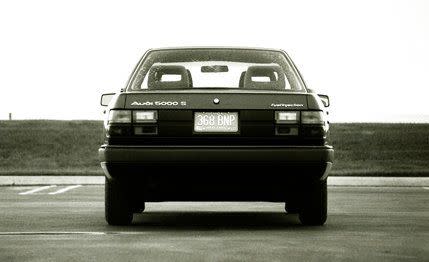
On the open road, what really matters is steering and damping. The first half of the equation is precision, predictability, linearity, and the feel of the car and the road through the steering wheel. The second half is how the chassis reacts to all kinds of inputs: bumps, dips, a stab at the brakes, a twitch of the steering wheel. In no particular order, the Pontiac, the Saab, the Audi, the VW, and the Volvo make their moves as one solid unit, while the Datsun, the Toyota, and the Dodge frequently feel as if their chassis were hinged at several locations. How much information you get through the tips of your fingers also varies from car to car. The Volvo and the Datsun have steering systems shot through with Novocain. The Audi and the VW are very light to the touch on center but extremely sensitive to small control inputs just the same. The Pontiac and the Dodge use commendably high effort levels, but both are curiously lacking in actual road feel. The Dodge, in fact, hammers back plenty of bump information through the steering, but little news about slip and grip down at the tires' contact patches. The Toyota is not bad for effort level, linearity, and road feel, and the Saab has one of the best feedback systems on the market.
Each car also has a particular damping "signature," determined by the shock valving selected by its chassis engineers. Both of the American cars have more than enough damping to hurt their ride at low and medium speeds but not enough to avoid some "floaty" feel at high velocities. The Datsun has neither enough damping nor enough suspension travel for optimum control. The Audi, the VW, the Volvo, and the Toyota all balance a smooth ride with well-managed body motions. The Saab is comfortably firm at all times, just as a sports sedan should be.
The great news here is that very competent sports sedans are now available from all four corners of the globe. The bad news, after we've had our say in the matter, is that choosing one from these eight capable candidates is your problem. —Don Sherman
Evaluating the Driver Environment
There are a few broad conclusions to be drawn from our week in Baja California with these eight sedans. First, fifteen years ago it would have been difficult, if not impossible, to find a selection of sports cars—at any price whatever—that would rush down the Baja Peninsula the way our eight four-door sedans did. So don't spend too much time making nostalgic noises about how they used to build 'em. None of our cars ever felt as if it was being asked to do something it couldn't handle (except when Sherman tried to make the Datsun swim underwater), and none of them ever felt as if it was being pressed beyond its limits.
Second, the electronic revolution may have given us better control of things like fuel injection and automatic transmissions, but it turns to silliness and gimmickry inside the driver environment. From talking Dodges and Datsuns to nagging chimes and the monitoring of systems that nobody needs monitored, the electronic wizards are becoming a pain in the neck. We pray that the car companies get over their childish fascination with the bells-and-whistles potential of automotive electronics and simply confine themselves to making cars work better. Well-lit round dials with numbers and needles still convey useful information more efficiently than red-orange starbursts, bar graphs, winking indigo digits, or mellifluous humanoid voices.
Third, one aspect of modern cars that is worse than it was fifteen or even ten years ago is shift linkage. Of the eight cars on this test trip, only the Toyota Cressida had a crisp, accurate shift linkage. Shame, shame. There's no excuse for vague, rubbery linkages on cars costing more than ten grand.
Fourth, the Japanese approach to turn signals, headlights, and wiper-washer controls is a good one. Headlights, turn signals, and low/high beams are all on the turn-signal stalk on the left, and washers and wipers are on a stalk on the right. Simple, handy, natural to use.
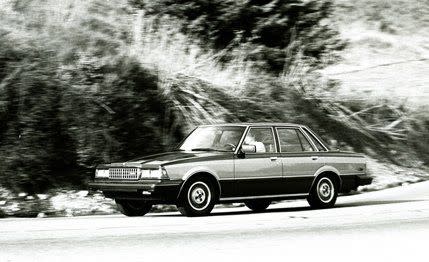
Finally, jumping in and out of eight different cars for several days convinced us that mirror controls ought to be close to the mirrors and electric-window buttons ought to be close to the windows. Hunting among the various switches and push buttons on the dash, trying to find the one that'll lower the driver's-side window so that you can pay a troll or explain your conduct to a Mexican policeman who sees you as dinner money, is ergonomically wrong.
Audi 5000S
Obviously a car designed by hard drivers for hard drivers. Audi and Saab seem to have been meant for this kind of abuse. Audi won on comfort and aesthetics, fell behind Saab and Volvo on utility. Center of dash was too busy; radio, window, heater-A/C controls generally disliked. Important controls such as steering, brakes, clutch above reproach. Superior rear seat, good trunk. Loved by one and all.
Saab 900 Turbo
Like meeting an old friend in the middle of nowhere. Excellent chair-height seats, visibility, instruments. Five-speed shifter rubbery and imprecise, especially when trying to find reverse (mandatory for removing ignition key from console). Window and mirror controls on dash okay for longtime owner but hard to find for occasional driver. On balance, a superb car for long, hard drives over bad roads.
Pontiac 6000STE
Generally regarded as best-looking interior of group. Suede upholstery was comfortable and provided lateral support through Velcro effect up to a point, but seats tended to go limp in really hard cornering. Most drivers wished STE had five-speed transmission, but manual would probably have pointed up engine's nonsporting power curve, masked by automatic. Excellent dash, but no tachometer.
Volvo 760GLE
Interior as nice as exterior kitschy. Roomy, comfortable, well finished, with handsome leather upholstery. Very much in keeping with legend of Volvo sensibility. Well thought out, with excellent automatic-transmission control and good layout of switches and instruments. Lacks oil-pressure gauge; radio controls low and hard to use. At its best when cruising at 60 to 70 mph.
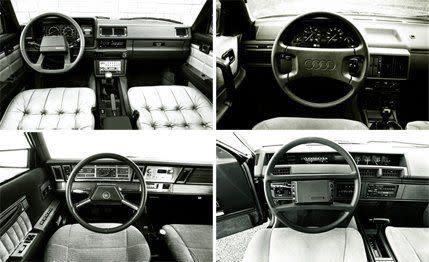
Volkswagen Quantum
A sleeper. Superficially unimpressive, but grew on drivers as miles piled up. Slowest car of group. Low performance, and automatic gearbox, forced drivers to press hard all the time to keep up. Interior simple and reasonably comfortable, though confined. Instrument panel refreshingly free of "Tokyo by Night" gimcracks. A nice car that inspires no superlatives.
Dodge 600ES
Not liked for its driving environment, despite excellent seats, control relationships, and visibility. Very poor shifting, universally disliked instrument panel and interior decor, buzzing vibrations prejudiced all drivers against this otherwise promising upgrade of the K-car. Comfortable back seat, commodious trunk, but seems to lack tight fit and finish essential for quality "feel."
Toyota Cressida
Nicest engine and driveline of entire group. Otherwise, strange feeling of déjà vu—Japan rediscovers the Sixties. Interior cramped, shoulder belts gimmicky, radio overly complicated. Good, legible instruments, supportive seats, nice combination of vinyl and cloth. As Datsun was spooky on straights, Toyota was imprecise, wobbly, in corners. Our friends in Japan not yet comfortable at this end of market.
Datsun Maxima
Optional Star Wars instrument panel and synthesized voice wowed local cops but irked test drivers. Cramped interior, too many colors, too many plastic pieces, numb steering. Least sure-footed (with Toyota) of all eight, required more attention to go fast and stay between ditches. Seats comfortable, transmission worked well, but lacked feeling of well-integrated, "whole" car. —David E. Davis, Jr.
What to See and What to Do in Sunny Mexico
So you're going to the Baja? You're buzzing with happy anticipation, boning up on the Berlitz, learning "Buenas noches" and “Excuse me, but I think this sandwich is made of dog." What to pack? Take lots of cheerful resort clothes (handy for spreading on the desert floor to signal airborne rescue parties). Take plenty of American money. Take a Valium. Take Interstate 15 back north, and stay in Palm Springs.
¿No, gracias? Then cross the border into Tijuana—adventure, here comes you! Total immersion in a different culture, different values... Don't be an ugly American and throw up. In Tijuana, garbage collection means displaying your collection of garbage in the street. But this is no excuse for forgetting the "good neighbor" policy the way some Americans did in 1846 when we stole half the country (the half with all the money and jobs).
Moving right along, let's zip down the beautiful four-lane, sometimes two-lane, occasionally no-lane highway to Ensenada with its breathtaking view of where the ocean would be if a lot of American recreational vehicles weren't parked in the way. On the road we see the quaint Mexican toll booths where they'll accept anything—yes, a button, an Oreo, a child's gym sneaker. This is the result of Mexico's interesting new currency system: each peso is worth 100 centavos, and the centavo is worth nothing at all. We gringos, we'll probably never "get it" how this works. But it's fun galore when you're bargaining for colorful hats in the shape of onyx ashtrays or blankets made out of old hats.
Don't miss the Museum of Third World Toilets (on display in Ensenada and everywhere else). Cheerful, fun-loving tour member Brock Yates did miss it and piddled in the parking lot of Hussong's Cantina. Considering the hygienic state of Hussong's, some cheerful fellow tour members saw this as an international gesture of good will and a cleanup attempt to boot, but the fun-loving, happy-go-lucky, very well-armed local police were not amused. "You have made the violation of a laws," they said (Spanish for "Give me ten dollars"). The Mexicans have an interesting method of paying their police: they don't. Just "free guns and all you can eat." Maybe some of our stateside big-city budget balancers should take a tip from this useful idea.
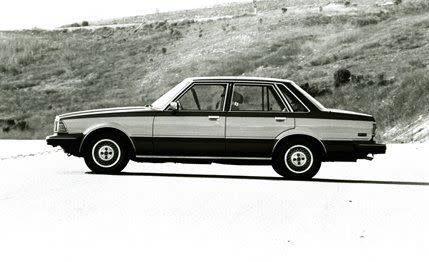
By the way, don't forget to stop at the checkpoint south of Ensenada and get your tourist permit stamped. Otherwise, it's illegal to go more than 100 kilometers south of the border. The checkpoint is closed weekends, holidays, nights, mornings, and siestas. Also, it isn't there at all. And remember, Mexico's traffic laws are different from ours. They're made up on the spot. Mexican roads are different, too. The Mexican Highway Department is known as the "Miracle of the Sierra Madre" because the entire national road system was built without surveyors' instruments, rulers, T-squares, or any of the sticky Stuff that holds asphalt together. The roads are a little narrow by U.S. standards—just room enough for a large truck in the oncoming lane and a large accident in yours.
Sun's down, ready for some fun? Night life is muy bueno in little desert towns like San Ignacio. Wade to your car. Drive a half-mile through water up to the doorsills, then a couple more miles to the little restaurant by the airport. Your genial hosts will try to trick you into eating the hottest salsa ever contained in a bowl and will fill your heart and mind with memories of home by playing their one American country-and-western tape over and over again. Yes, when night falls in old Mexico, anything goes. And everything was gone by the time we reached San Ignacio.
The Baja has plenty of beautiful scenery. Or maybe it doesn't. Who can tell? Cheerful (well, sort of) tour guide Don Sherman loves to go hippity-hop quick as a bunny down Mexico's amusing roads—terrific view of white knuckles clenching sweat-drenched steering wheel. And for extra fun at 100-plus, be sure you have a front-wheel-drive car that doesn't give any tedious old advance warning when it goes for a closer look at the Baja's flora and fauna. Speaking of flora and fauna, everything that's more than three feet from the highway is poisonous, has thorns, or is armed with a .45—a naturalist's paradise! (Keep car doors locked, and beep horn until marines arrive.)
Some stick-in-the-muds say you shouldn't drive at night south of the border. You might hit a cow or something. A lot of malarkey, say we. (Write care of this magazine for good deals on genuine Mexican beefsteak and a Dodge 600ES front end, used hard only once.)
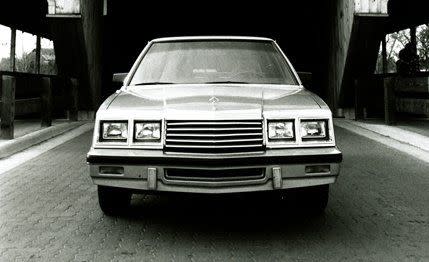
The rest of the food in Mexico is fabulous, too—broiled langostino, succulent yellow-fin tuna, tasty carne asada, beautiful salads, and fresh vegetables. And here's a sure-fire hint for avoiding tummy troubles: don't eat any of it. Fun-imbibing tour member David E. Davis, Jr., has a great method for finding all the best Mexican restaurants—stop where the flies do! Can eleven million insects be wrong? David E. likes his roadside stops double-rustic. Not just dirt floors but dirt ceilings, too!
Did someone say sickness and danger? Fun-swamped tour member Jean Lindamood discovered that ignorance of Spanish is no barrier to not making sense in Mexico. She just tacked "-o" and "-idad" onto the ends of all her regular English words and chatted away like a house afire. The natives thought this was no end of fun, but then again, their national sport is teasing farm animals with a red bed sheet. Mexican officialdom was eager to give us a tour of the country's penal facilities—their way of saying thanks for our speeding, traveling in an illegal convoy, speeding again, being so fun-filled, having cow accidents, and speeding some more—but they could never resist Jean's happy patter. She'd show them our official papers (proper official papers in Mexico have pictures of Washington, Lincoln, and Jefferson on them), and we'd be on our way again.
Of course, Jean was more than just a great conversationalist. She got directly involved in native life—siphoning gas from American automobiles in Santa Rosalía, stealing the federale's squad car in Loreto, and driving around town with his girlfriend. On second thought, maybe we got special treatment because the Mexicans believed if they detained us, they might have to keep Jean, too.
Yes, you'll want to stay in Baja forever, the way we almost did. Ah, the sights, the smells, the vistas, the stronger smells, and the wonderful, beautiful weather. The weather in Baja is incomparable, glorious the year round. Don't call it rain, call it liquid sunshine. Why, the climate is so warm and dry that the Mexicans don't even bother to build bridges. They just pave right across the bottom of the arid river beds and never have any problems at all with... WHERE'S SHERMAN?! JESUS CHRIST, GET ROPE!! GET SANDBAGS!! Happy touring, amigos, and adios for now to the cheerful, fun-filled... BAIL, FOR GOD'S SAKE!! BAIL!!! MAYDAY! MAYDAY! MAYDAY! MAYDAY! —PJ. O'Rourke
A Plenitude of Powertrains
Powertrains are perhaps the most diverse of automotive components. Even in a group as closely matched in size, weight, and purpose as these sports sedans, every car has a unique solution to the motivational problem. The variety reflects not only different technical opinions, but also the distinct philosophies of the world's automakers.
In Europe, sports sedans have traditionally been overachieving versions of standard sedans. They are expected to have greater performance, better handling, and more sporting characteristics without sacrificing their capacity for workaday chores. To help them be such well-rounded performers, their engines have typically been lavishly endowed with exotic design features, not merely enlarged or crudely souped up.
The Volvo 760GLE's engine is representative of this design philosophy. It's a 2.8-liter, all-aluminum 90-degree V-6 with fuel injection, chain-driven overhead cams, and wet cylinder liners. These features are good for 130 hp at 5500 rpm and 153 pounds-feet of torque at 2750 rpm, which is a suitably broad spread of power for the Aisin-Warner four-speed automatic to which this powerplant is coupled.
The Saab 900 Turbo's engine is equally exotic but in quite different ways. Since there is little room under the 900's hood for anything larger than Saab's excellent fuel-injected, 2.0-liter, overhead-cam in-line four-cylinder, the engineers turned to turbocharging to find more power. Furthermore, they invented the APC (automatic performance control) system, which monitors the engine with a knock sensor and holds boost pressure to safe limits under all conditions. This safeguard allows the engine to have a high compression ratio (for a turbo motor) and aggressive spark timing. Combined with a five-speed transmission, the resulting 135 hp makes the Saab one of the liveliest sedans in the world.
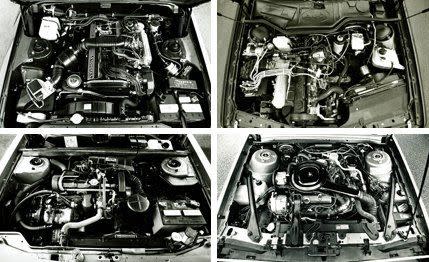
Compared with the Swedish powerplants, the five-cylinder engine shared by the Audi 5000 and the Volkswagen Quantum seems a bit tame. Based on the corporate VW/Audi four-cylinder, the five strikes a compromise between the size of a four and the smoothness of a six. Although it does have an overhead camshaft and fuel injection, the noncrossflow head design and the in-line valves keep this five from being a high-rpm screamer. But its broad power band is as well suited to the Quantum's three-speed automatic as it is to the 5000's five-speed manual.
In contrast to the European philosophy of exotic design, American engines have always been judged more for what they do than for how they do it. For example, the Pontiac 6000STE engine is a 2.8-liter 60-degree V-6, with the only pushrod valvetrain and cast-iron cylinder heads in this group. It doesn't even have fuel injection, yet it delivers 130 hp at 5400 rpm and 145 pounds-feet of torque at 2400 rpm, which compares well with the far more exotic Volvo V-6 of similar size.
The Dodge's 2.2-liter in-line four is not quite as pedestrian as the Pontiac's engine, for it does have an overhead cam and an aluminum head, but the Chrysler Corporation has also eschewed the complexity of fuel injection. Compared with the VW/Audi powerplant of similar displacement, though, the Dodge four has just a bit less power, a bit more torque, and similar fuel economy. It also enjoys the broad power band necessary to match the ultrawide ratios of its five-speed.
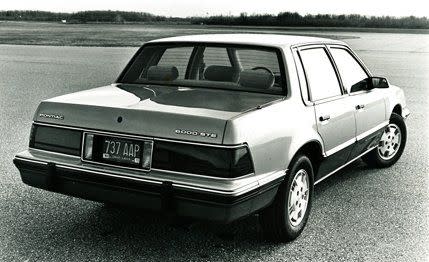
As the world's late-comers to the sports-sedan business, the Japanese manufacturers are too insecure to rely on results alone. Instead they borrow from their sports-car heritage and outfit their cars with all the technical credentials they can muster.
Datsun's approach is to capitalize on the 240Z's reputation by using an updated version of its engine to power the Maxima. With 2.4 liters, six cylinders in line, and electronic fuel injection, it can certainly hold its own among the other engines in the group.
For the Cressida, Toyota engineers also settled on an in-line six, but they reached all the way back to the 2000GT for their sporting credentials: a twin-cam, crossflow head. Coupling the 143-hp motor to a five-speed transmission and a 3.73 axle ratio ensured the Cressida's performance image.
It becomes clear from this diverse picture that no single philosophy or technology has a lock on performance. As ever, there are many ways to light up a tire, and the automotive world is all the more interesting as a result. —Csaba Csere
The Final Tally
If you peel back the seemingly frivolous layers of this adventure story, you will find the heart of the matter: How well does America's new breed of medium-priced, European-style family sedans compare with the best in class from Japan, Sweden, and Germany?
The day of reckoning came in San Ignacio, Baja California, Mexico. We had driven the eight cars some 1650 miles. We'd killed a cow and sunk the Datsun, and we were now marooned between rising flood waters. Making the best of a bad situation, we dug in with a case of Carta Blanca and a sheaf of ballots, and in the midst of the mud and the blood and the beer we endeavored to find some answers.
The eight candidates were judged in nine areas of relevance to the family-sedan class. The point system was a simple one-two-three rating (below average, average, and above average). Nine of us cast a total of 648 separate votes, which were tallied, audited, and arranged in the downloadable chart. Rather than rank the cars overall, we've printed the high scorer(s) in each category in bold type. Our perusal of the final vote prompts some random observations:
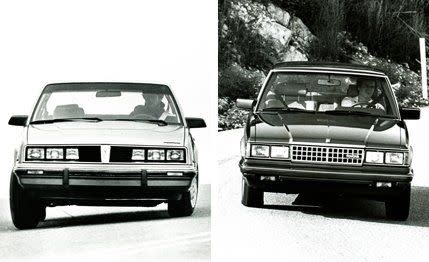
• Japan's best fared poorly in general. Both the Toyota Cressida and the Datsun Maxima are growing whiskers, which are especially noticeable with so many fresh faces around. Rear drive consumes an uncomfortable amount of their cabin space, both cars have gone a bit soft around the edges, and the typical plethora of buttons and gadgets has reached the point of sensory overload. Japan's strong suits are still technically advanced powertrains (the Cressida's earned a perfect 27) and reasonable price tags.
• The Saab's exterior shape is coming into its own. Its interior scored less well, in spite of a new Bridge of Weir leather option. The opposite holds true for the Volvo. Compared with their rivals, both are too expensive.
• We liked all the powertrains with the exception of the slow Quantum five-cylinder and the overworked Dodge 2.2-liter four. The Dodge was also dunned for its abominably balky cable shifter.
• The cable shifter and a genuinely awful instrument panel did the most damage to the Dodge's image. In all, the 600ES did well, though, with the fourth-highest total of above-average ratings. Aside from the official vote, the cow-killer also deserves special mention for true grit. If you could only picture the Dodge as we can, making its way through the treacherous mountains of the Baja Peninsula with no hood.
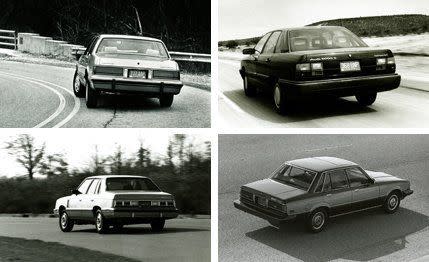
• It's readily apparent that the Audi 5000S is the hands-down standard-bearer of the family-sedan class, with the highest ratings in the most categories. We awarded but three perfect scores of 27, and the Audi received two of them. Its lowest score was a 21.
• Pontiac's new 6000STE is a dandy. It nips at the heels of the Audi coming and going, and it's the only other car in our group to rate above average in all nine categories. We knew we liked the STE, but frankly, we're pleasantly surprised at the degree of its success.
For the first time in years, Detroit has a firm grip on building world-class sedans. The Dodge could use more polish, but the 6000STE is virtually there. It's been a long time coming, we'd say. —Jean Lindamood.
You Might Also Like

 Yahoo Autos
Yahoo Autos 